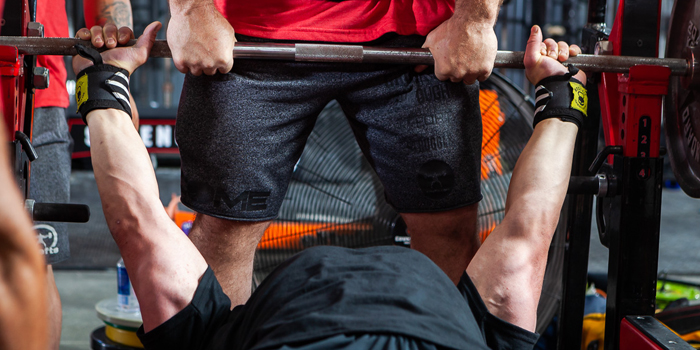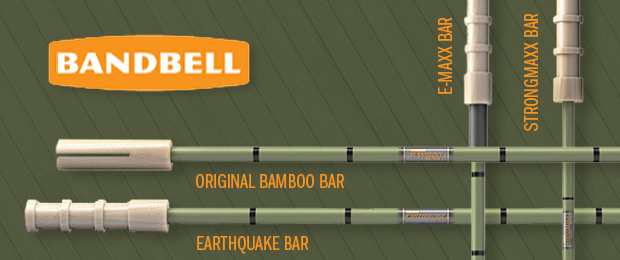
We’ve all heard the phrase “big back, big bench” at some point in time, and it has been a debated matter over how much your back actually plays a role in the bench press. I wanted to weigh in on the topic as a strength coach who specializes in the bench and as an athlete who has benched more than 700 pounds in competition.
My opinion? The back plays an enormous role in benching effectively! The problem? Very few lifters actually understand how to use their back efficiently in the lift. This is why I have an issue with studies that show low EMG activity in the back during the bench. Take a bunch of random, everyday gym goers and it’s no wonder there’s not much back activity—90% of powerlifters who practice the move regularly don’t even excel at it!
RELATED: How to Program Your Back Training at the U
Benching effectively with the back is by far the hardest concept to grasp as a lifter and the hardest subject to teach someone. It is a concept that is best learned with time. Even when you think you’re using your back, you likely aren’t, or not as well as you could be.
With this article, I want to share my favorite exercises to improve back strength relative to bench pressing, and some technical exercises to get athletes using their backs more efficiently. You can have the strongest back in the world, but unless you know how to take advantage of it, it doesn't mean much.
Training Back For Bench
Let’s start with building back strength because vice versa, even if you knew how to use it, if you don’t have it to begin with, it doesn’t mean much. Let’s first take a look at how the back is used during the bench press. As you’re descending and pressing the bar, the back is working statically! Meaning you’re not actively rowing per se but rather creating stability and a stable platform to press off. It’s a big isometric contraction. So, what’s my favorite way of training the back specific to the bench press movement? Training static holds!
Seated Row Hold
This is a go-to of mine because it does just that—it trains your bench statically! With this move, we want to replicate our benching position as much as possible. Set-up by sitting tall, with shoulders, back, and chest lifted as you would be while benching. Take your bench grip to the bar, and as you row in, touch the same point on your chest that you would during the bench. You are going to hold the row for time. Anywhere from 15-30 seconds suffices. I like using bands, but a cable or other modalities can be used, too.
Lying Bench Row
This is another back exercise that can be used both statically and for reps. Perhaps there is no more specific a move than this because you are literally mimicking your bench position. You perform this exercise lying down, with a bar suspended by bands. I program this move both for time and for reps. Like all back exercises, I think a combo of both is the best way to go!
Seal Row
This is a big back-building move because it allows you to load up that weight! Any move that allows you to load up weight delivers a great training stimulus (e.g., squat, bench, deadlift!) These can be trained with reps or holds as well. This is just a bench press thrown in reverse! A great move that will really instill confidence in your back training. You’ll see and feel the results with these!
Lying Lat Pullover
This is a unique back-training move that I like to perform regularly. It replicates the take-out portion of the bench. A huge role of the back in the bench is during the take-out phase. Often overlooked, this is when you need to sink that bar into your back, load the lats, and lock down the upper back. These are all things you can practice here with the lying lat pullover. I love doing these banded with our Tork Bar as seen in the video. I use holds for the most part but will also train low reps to get the feel of the take-out. Visualization is important when performing this exercise in an effort to connect it to that portion of the bench.
Benching With Your Back
Now that you know how to gain that back strength, let’s take a look at the technique that goes into using your back in the bench press! This is the secret piece of the puzzle. This is where the majority of lifters fail to make the connection. Once you learn how to truly “bench with your back,” it starts to click, and all of a sudden, you're controlling weight better, there is less stress on your shoulders/elbows, the weight is moving more easily—all of these great things start to happen.
Bending The Bar
This is a cue we hear all the time, but a surprising majority of lifters don’t connect with this cue correctly. Either they bend the bar in the wrong fashion or they cannot connect the concept of torquing into the bar with the use of their lats. In turn, this puts more stress on the joints of the arm more than anything, and they end up over-tucking the elbows. In this video, I demonstrate how the bar should look when it is being “bent” and how to connect that motion deep into the back. This is the first step to actually using your back while you bench.
Pinch and Tuck
The other role the back is going to play in the bench is maintaining your shoulder position. A big component of the bench is the set-up process. Once you get yourself into a good position, you need to work equally as hard to maintain it throughout the set. Keeping the shoulder blades pinched together and tucked underneath you is something your back does and another reason why we want to reinforce this action and train it every time we do accessory work. Don’t get relaxed doing your smaller movements; keep that good position with the shoulders.
Upper Back Use
This is probably the component that lifters are missing the most: the action of driving their shoulder blades down toward their hips. This comes into play heavily as you take the bar out but also maintain it throughout the set like anything else. My cue is shoulder blade to hip. You can also say slide your rear delt down the bench, or lift your chest to the bar.
“Catching” The Bar
I have found this cue to be particularly helpful in helping a lifter to finally start to connect the back to the lift. When you think about “catching” the bar with your back, you tend to control less at the arms and start to feel how the back can create that platform of stability for you to press off. It’s a simple yet very effective cue, and I guarantee that if you go into your next session with this on your mind, you will feel a difference!
Earthquake Bar
There isn’t a tool I love more than the Bandbell Earthquake Bar for teaching a lifter how to finally put all of the pieces together! The instability it creates is a perfect environment for a lifter to learn how to use his or her back effectively to create stability once again. Someone can immediately feel the difference between trying to control the bar through the arms versus actually using the back to create stability. It delivers immediate feedback and could very well have been included as a training tool, too, because it works just effectively as one!
Build That Back, PR That Bench!
A great bench starts with what you cannot see in the mirror, and how you use it. Remember, a big back does not necessarily guarantee you results, nor does having the precise execution of your back without any strength behind it. The two go hand in hand. Strength and execution as always are your keys to success in this area.
Now that you have the exercises and cues to build both, as Ronnie Coleman says, “ain’t nothin’ to it but to do it!”
My website www.bigbenchas.com and my YouTube channel Big Benchas is dedicated to providing all the content you need to take your bench to the next level. I cover every aspect of how to perfect the technical side of bench pressing. I encourage you all to reach out to me for additional training help. You can reach me at coachben@bigbenchas.com.











2 Comments